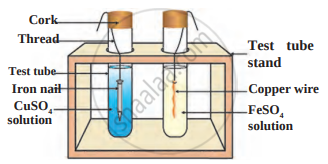Advertisements
Advertisements
Questions
Name two metals which will displace hydrogen from dilute acids, and two metals which will not.
Name two metals which can displace hydrogen from dilute acids.
Solution 1
Iron and aluminium will displace hydrogen from dilute acids as they are more reactive than hydrogen. Metals such as Mg, Al, Zn, Fe, etc., which lie above hydrogen in the activity series, are more reactive than hydrogen and hence can displace hydrogen from dilute acids.
\[\ce{\underset{Zinc}{Zn_{(s)}} + \underset{Sulphuric acid}{H2SO4_{(aq)}} -> \underset{Zinc(II) sulphate}{ZnSO4_{(aq)}} + \underset{Hydrogen}{H2_{(g)}}}\]
\[\ce{\underset{Iron}{Fe_{(s)}} + \underset{Hydrochloric acid}{2HCl_{(aq)}} -> \underset{Iron(ll) chloride}{FeCl2_{(aq)}} + \underset{Hydrogen}{H2_{(g)}}}\]
Solution 2
Sodium and magnesium are two metals which can displace hydrogen from dilute acids.
APPEARS IN
RELATED QUESTIONS
Diamond : electric insulator : : _______ : electric conductor
Example of an amphoteric oxide is:
Which one of the following metals does not react with cold as well as hot water?
Stainless steel is very useful material for our life. In stainless steel, iron is mixed with
If copper is kept open in air, it slowly loses its shining brown surface and gains a green coating. It is due to the formation of
The metal which produces hydrogen gas on reaction with dilute hydrochloric acid as well as sodium hydroxide solution is
Zinc sulphate forms a colourless solution in water. Will you observe any colour on adding copper turning in it?
Material: Copper wire, Iron nail, Beaker or Big test tube.
Chemicals: Ferrous Sulphate and Copper Sulphate Solution.
- Which reaction you will study with the help of the above material and solutions? Draw the diagram of the experiment arrangement.
- How do you identify that the reaction is carried out?
- Which type of reaction did you observe?
Answer the questions based on the figure below:

- Which experiment setup is demonstrated in the figure?
- What do you conclude after the reactions? Name reaction.
Keerti added dilute Hydrochloric acid to four metals and recorded her observations as shown in the table given below:
| Metal | Gas Evolved |
| Copper | Yes |
| Iron | Yes |
| Magnesium | No |
| Zinc | Yes |
Select the correct observation(s) and give chemical equation(s) of the reaction involved.
Metal oxides generally react with acids, but few oxides of metal also react with bases. Such metallic oxides are:
- MgO
- ZnO
- Al2O3
- Cao
Select the appropriate state symbols of the products given as X and Y in the following chemical equation by choosing the correct option from table given below:
\[\ce{Zn_{(s)} + H_2SO_{4(l)} ->ZnSO_{4(X)} + H_{2(Y)}}\]
Write a chemical equation showing the ionic products formed on dissolving potassium hydroxide in water.
On adding dilute sulphuric acid to a test tube containing a metal ‘X’, a colourless gas is produced when a burning match stick is brought near it. Which of the following correctly represents the metal ‘X’?
